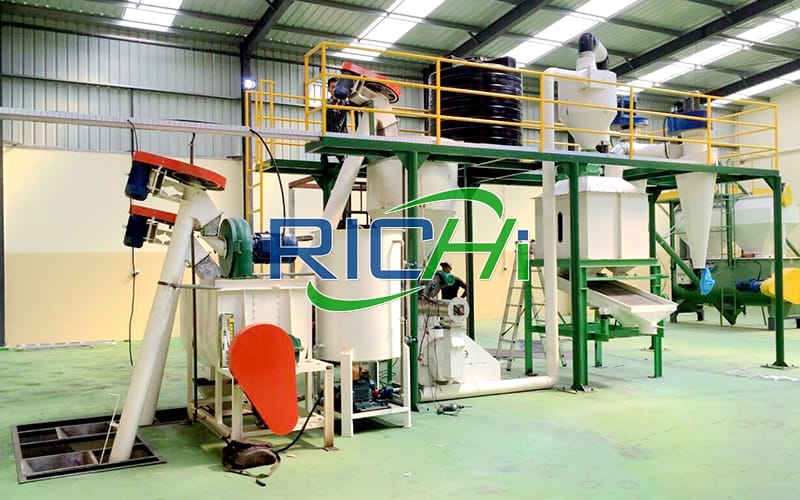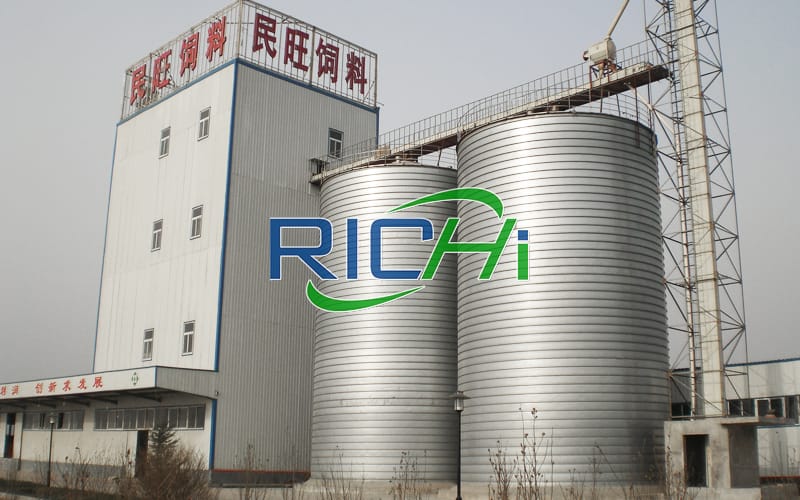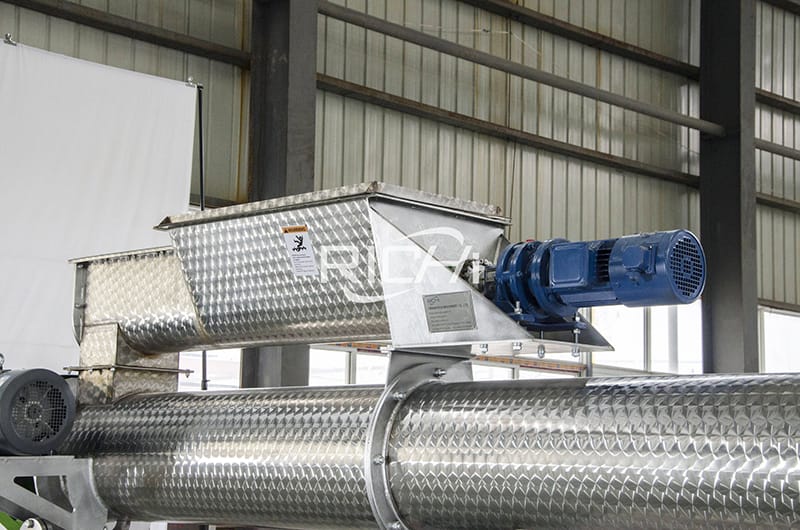It is understood that many poultry feed mill factories have failed to meet the expected design requirements due to the process arrangement and operation technology of the pelleting machine for making poultry chicken feed, and the pellet surface is not smooth, low in hardness, easy to break, and high in powder content. The main reasons that affect the production efficiency of the high quality poultry feed pellet mill machine during the pelletizing process are analyzed as follows:

(1) Raw material factors
The raw material factors directly affect the effect of pelletizing. The materials with higher starch content are easy to be gelatinized by steam. These raw materials have a certain viscosity after tempering, which is conducive to the formation of granules. For raw materials with high crude fiber content, adding a certain amount of grease can reduce the friction between the material and the ring die during granulation, which is beneficial for the material to pass through the ring die, and the appearance of the particles after forming is smoother.
The general addition amount is about 1%. If the addition amount is too high, it is easy to cause loose particles. If you need to add more fat, you can consider spraying after granulation, which is especially suitable for the production of high-energy feed. The particle size of the crushed raw materials determines the surface area of the feed composition. The finer the particle size, the larger the surface area, and the faster the material absorbs moisture in the steam, which is beneficial to the conditioning of the material and is also easy to pelletize.
From the point of view of granulation, the crushing is fine and the granulating strength is high. However, if you add more steam, it is easy to block the machine if you don't pay attention to it, and the raw materials are crushed too finely, resulting in high power consumption for crushing. Too coarse particle size will increase the wear of the ring die and pressing roller, making it difficult to form pellets, especially the small aperture ring die, and cause poor material gelatinization, resulting in high material consumption, low output, and high particle powder content.
Therefore, in the poultry feed pelletizing line production process, a 2.5-3.0mm sieve plate should be used for crushing corn, which can avoid the disadvantages of too fine particle size and ensure the required particle size for sufficient conditioning of the feed, which is beneficial to reduce the powder content of the particles. In addition, attention should be paid to the uniformity of mixing before pelleting, because the composition of the feed formula is complex and the proportions of various raw materials vary greatly. For different formulas and varieties, different mixing times are used to make the coefficient of variation of mixing uniformity reach about 5%. The subsequent granulation process lays a good foundation.

(2) Feed flow control
In order to make the poultry feed granulator work at full load in a balanced manner without stopping, the flow of material entering the poultry feed pellet maker machine must meet the granulation needs, and the poultry feed structure must effectively eliminate the intermittent feeding caused by agglomeration. Take the SZLH420 poultry feed machine for making chicken feed as an example. The material flow rate should not be less than 10T/H. In actual poultry feed line production, the material flow of the feeder should be adjusted to be stable. It is more reasonable to install a buffer bin directly above the granulator. The buffer bin, or the long connecting pipe (above 0.5m) between the buffer bin and the feeder, makes it difficult to ensure a stable incoming material volume.
When the production efficiency of the poultry feed pellet making machine is not normal, many poultry feed mill plants are just busy looking for the cause in the electric poultry feed pelletizer machine itself, and ignore the incoming material factor. In fact, many times the poultry feed production efficiency decline is caused by the instability of the incoming material flow. Generally speaking, when the granulator is running smoothly and normally, the steam supply is sufficient, the feed gate is fully opened, the feeder speed is adjusted to the rated value and the main motor does not reach the rated electric value, it can be judged that the incoming material flow is insufficient , At this time, the cause should be ascertained and treated according to the symptoms.
(3) Steam quality control of poultry animal feed manufacturing equipment
The use of steam granulation can effectively increase the output of the poultry feed pellet manufacturing equipment and improve the quality of the poultry feed pellets. Steam is the source of water addition during conditioning, and the heat source of gelatinization of feed starch. Adding a certain amount of steam to the conditioning can kill part of the bacteria in the feed, but also dilute the natural binder in the feed, so that every particle in the material forms a thin water layer outside, which is conducive to the gelatinization of the material. It is convenient for pelleting, thereby improving the quality of pellet feed.
The correct steam pipeline design must ensure the steam pressure and flow, and effectively prevent the condensate in the pipeline from entering the conditioner. The steam drum should be as close as possible to the pelletizer to improve steam quality, because steam quality is very important to the poultry chicken feed pelletizer. Steam with insufficient purity will cause the pelletizer to block or produce unqualified feed, and is prone to a series of failures. The suitable saturated steam pressure should be 0.2~0.4Mpa. When the pressure is too low, the quenching and tempering index cannot be reached in the fixed quenching time; when the pressure is too high, the steam temperature is also high, and the steam passes through the conditioner to increase the heat conduction of the material. Increased temperature can easily cause high material temperature, low moisture, and local material scorching, which will affect the granulation quality.

To ensure that the steam pressure is always stable, the pressure fluctuation range should generally not be greater than 0.05Mpa, and the steam pressure is inseparable from the design and correct installation of the steam piping system. Generally, the water content of raw materials is about 12% before quenching, and the steam pressure is high and the water content is low. Therefore, lower pressure steam can be selected for low-moisture materials. When the moisture content after quenching and tempering is greater than 16.5%, the produced particles have high moisture content and are not easy to store for a long time; when the moisture content after quenching and tempering is less than 15%, the granulation consumes more electricity and the crush resistance rate is low.
The tempering temperature is closely related to steam pressure and steam consumption, and also changes with the seasons. Generally, the tempering temperature of poultry feed is about 85 degrees. The room temperature in winter is low, and the tempering temperature should be lower. In summer, the room temperature is higher and the tempering temperature is higher. The steam pressure is high, the amount of steam absorbed by the material is small, and the gelatinization is poor, which is suitable for the material with high moisture content. The steam pressure is low, the amount of steam absorbed by the material is large, the absorption of water is also large, and the gelatinization is good, which is suitable for materials with low moisture content.
(4) Production operation of hot sale ring die poultry animal feed pellet making equipment
Correctly control the gap between the pressure roller and the die. If the gap between the roller die is too small, the die and the pressure roller are easy to wear, and the super noise is large; if the gap is too large, the material extrusion will be affected. Generally controlled within 0.05~0.30mm. It can be measured with a feeler gauge during adjustment, or visual inspection without a feeler gauge. Take the new ring die and the new press roller as examples. Visually inspect the press die and press roller as if it is not reliable, but when there is no material, it is better that the host rotates the press die and cannot drive the press roller. It is especially emphasized that the new die should be equipped with a new roller and the gap should be smaller.
In addition, enough butter should be added to the pressure roller (usually select high-temperature-resistant No. 7 lithium base grease) to avoid burning the bearing due to excessive temperature. At the same time, the feed scraper should be adjusted, otherwise it will be difficult for the material to enter between the press roller and the press mold, and some of the material will be strung out from the press mold cover, forming a high particle size. The adjustment result should be the upper edge curve of the scraper. The gap between the die and the die cover is basically controlled between 2~3mm, and the front end of the scraper should not exceed the undercut groove of the inner hole of the die.
After adjusting the various parts of the poultry chicken feed granulator, the machine can be granulated. Turn on the poultry feed pelletizing machine, conditioner, and feeder first. At this time, the feeder should be in a small feeding state. In order to prevent the debris from entering the die, the outside discharge door on the operating door should be opened to drain the material mixed with debris in the machine. After the miscellaneous materials are cleaned, the materials can be introduced into the die. For the sake of precaution, you should hold the handle of the discharge door outside the machine with your hand, first let part of the material enter the mold, and then observe whether there are pellets smoothly out of the mold, and pay attention to the current changes. If the pellets can be produced normally, the current is relatively stable, the fluctuation range is small, and the rated current is not reached, then the material flow can be increased, and the steam volume can be increased at the same time until the rated current is reached.
If the material enters the granulating room, but no particles are ejected from the mold, and the current is constantly increasing, this is to open the discharge door outside the machine to observe whether the current drops when the material is continuously fed. If the current drops and some particles are ejected from the mold at the same time, you can hold the handle of the discharge door outside the machine to let part of the material into the die and part of the material to be discharged. Observe whether the current is stable and whether the pellets from the die are smooth.
If the current does not decrease after stopping the feed, or even continues to rise, the automatic poultry feed pellet producing machines should be shut down to check the cause and treat the symptoms. It is worth reminding that, during the initial discharge, do not rush to add steam, because at this time, the material is small, the steam is difficult to add to the ideal amount, the steam is large, the material is small, and the machine is easily blocked. It is better to wait until the material is added to a certain amount. It is safe to add steam. In addition, the oily material replacement material must be added into the die before the granulator stops working. The purpose is to prevent the material in the die hole from hardening, so that the die can be discharged smoothly next time it is turned on.

(5) Ring die of automatic poultry feed pellet milling machine
Whether the material can be squeezed through the die during the granulation process depends on the pressure and friction that can be generated in the die hole. This is related to the friction coefficient between the material and the die wall, moisture content, raw material particle size, temperature, buffer time of the plastic deformation part of the material and the compressibility of the material. These characteristics are closely related to the die hole depth and aperture. Generally speaking, the compression ratio of the die hole diameter should be 1:8~1:13 (that is, the effective thickness ratio of the die hole to the die), the compression ratio of the die is small, the effective length of the die hole is short, and the material with pressure formed in the hole is small and it is easy to extrude the ring die.
Therefore, the output is high, but the produced pellets are loose, the powder content is high, and the appearance is not smooth; on the contrary, the longer the effective length of the compression hole, the more the material is in the die hole. The greater the pressure, the higher the compactness of the pellets produced, the smoother quality of the pellets, and the lower the powder content, but the output of the pellet machine for feed poultry chickens will decrease, and of course the power consumption per ton will increase accordingly. Therefore, when feed manufacturers produce pellets of different specifications and varieties, the aperture ratio of the ring die will be different.
RICHI SZLH series ring die poultry pellet press machine series:
- 1-2t/h Ring Die Poultry Feed Mill Equipment
- 3-4t/h chicken poultry granule feed pellet mill machine with ce
- 5-7t/h CE certificate poultry food animal feed pellet mills
- 8-12t/h CE ISO approved Poultry Feed Pellet Mill Machine
- 10-18t/h CE verified Poultry food pellet mill
- 15-25t/h poultry feed manufacturing equipment
- 20-30t/h factory direct supply commercial poultry animal feed pellet mill
- 25-40t/h poultry feed pellet mill making machine
- 28-45t/h High Quality Poultry Feed Pellet Mill


